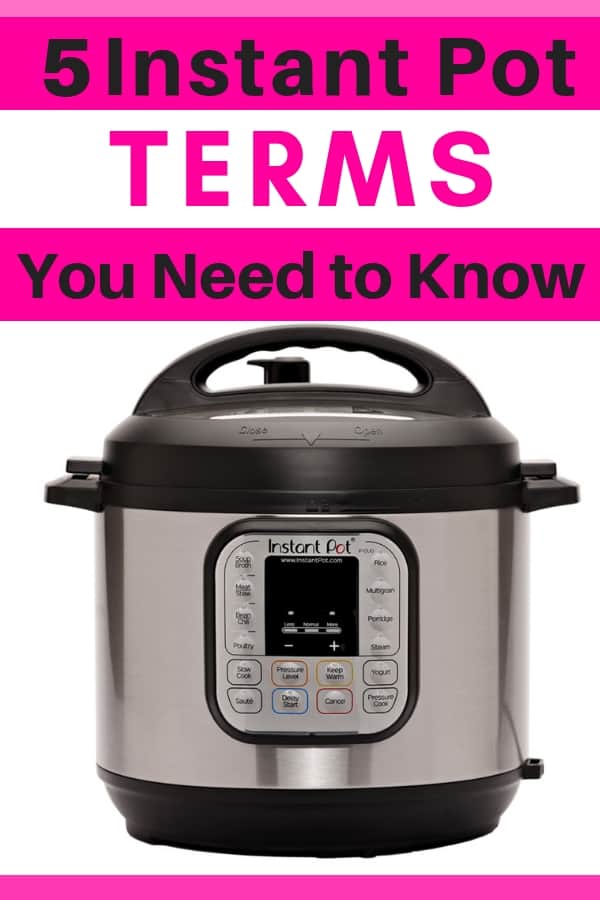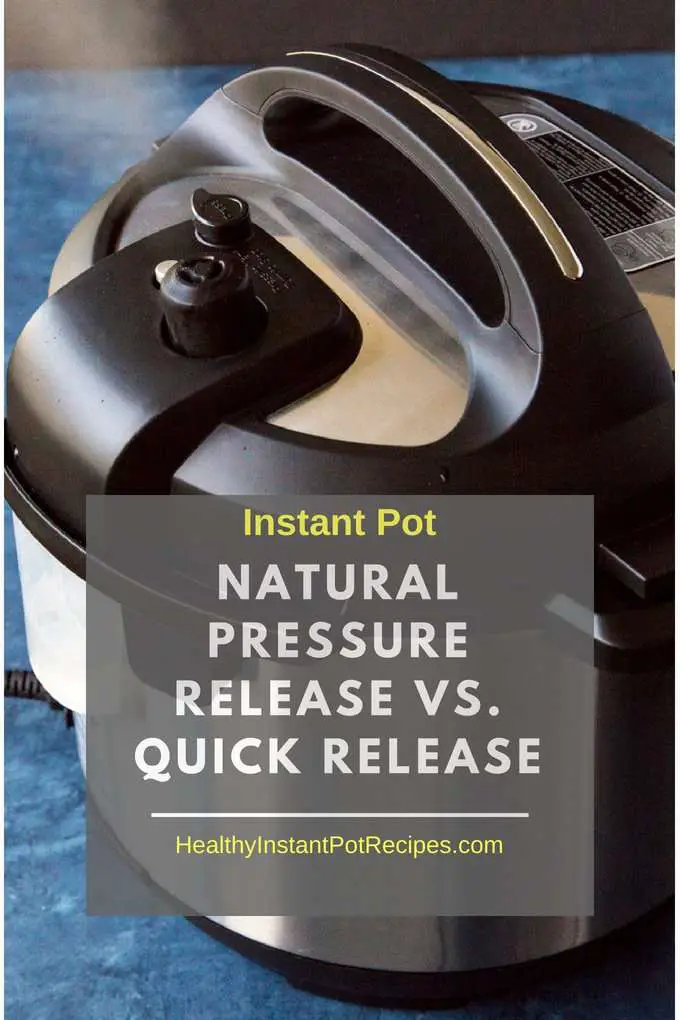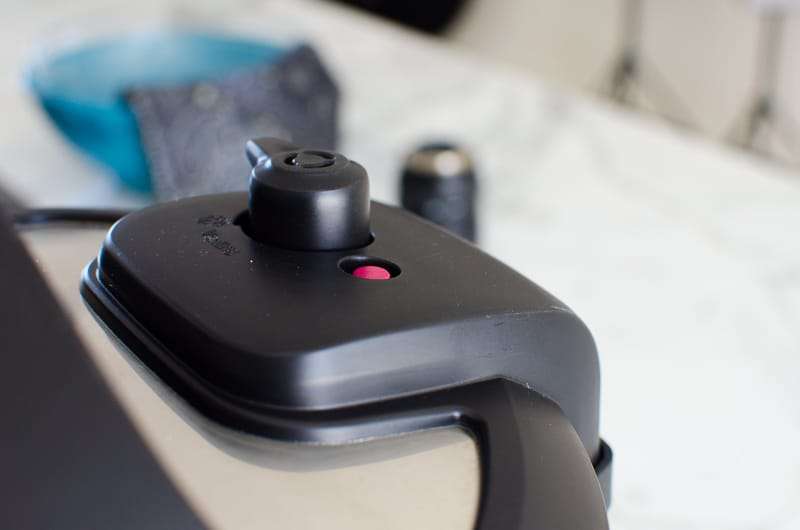Instant Pot Natural Release Not Working Heres How To Fix It
Instant pots are popular among many households and are great for cooking tasty meals in half the time.
An instant pot natural release can be broken and not work due to a mechanism that is stuck or a smaller piece of food such as rice or grains is stuck and causing the natural release to stick. This can be fixed by replacing the valve or cleaning the valve after each use.
In this article, we are going to talk about what can cause an instant pot natural release to stop working, how to fix and what you should be doing to care for your instant pot.
How To Do A Natural Release
1. Upon completing the cooking cycle, your Instant Pot beeps to signal it completed the cooking cycle.
2. Most Instant Pot models automatically begin to use NPR.
3. The process is complete when you see or hear the float valve drop down.
4. Taking the lid off of your Instant Pot vents any remaining pressure.
How To Do A Quick Release In Bursts
A quick release in bursts can take up to 5 minutes. You can keep the Keep Warm mode on or off while doing a quick release in bursts. If you wish to turn this mode off, press Cancel.
Read Also: Can You Make Noodles In An Instant Pot
Want More Practice Bring It Back To Pressure
Try it again with the same hot water. This time, press Manual and then adjust the 30 minute default time by pressing the button, then press the + button to go up. Lets do 10 minutes.
You may notice how, if you press Manual and take too long before pressing the other buttons, the cooker will just beep on its own and proceed for 30 a minute pressure cooking time. If you need to re-start, just press Cancel/Keep Warm and start over.
Since the water is in your cooker is already almost boiling to begin with, the cooker will come to pressure a lot faster than it did the first timewithin a minute or so. Itll hiss, then the hissing will abruptly stop as the pressure indicator button goes up. If the hissing just keeps on going, its probably because you left the valve in the venting position instead of sealed. Just use your spoon handle to nudge it back.
What next? Same as before: the cooker beeps, the readout will say 10, and then it will switch to LO:00. You can do quick or natural release, whichever floats your boat.
Coco Morante
My Instant Pot Isnt Searing Very Well

Sautéing with your Instant Pot is convenient, but it can be challenging to get a decent sear on specific cuts of meat. We recommend opting for a different appliance entirely to sear most larger-cut foods, like steak, because your Instant Pot wont get hot enough to execute a deep sear. Smaller cuts of meat may prove to be successful, but we cant promise that the meat wont become chewy or soggy. Searing is not the Instant Pots strong suit, so you should leave that job up to your trusted frying pan.;
Editors’ Recommendations
Recommended Reading: How To Cook Farro In Instant Pot
Whats Up With All Those Knobs And Buttons
I know, there are so many. Good news! You can ignore most of them. I use my Instant Pot nearly every day, and Ive never touched the Rice, Porridge, or Soup buttons. I do, however, make rice, porridge and soup in my IP all the time, just by programming it manuallywhich you need to know in any case.
For now, were focusing on the buttons you need for most pressure cooking recipes. If it helps, just get masking tape and cover up those other buttons so that you only focus on the buttons needed for our test drive:
- On the Instant Pot Duo: the Low Pressure and High Pressure buttons, the +/- Cooking Time buttons, the Manual button, and the Keep Warm/Cancel button.
- On the Instant Pot Ultra: Cancel and Start buttons and the central knob
Alison Conklin
Why Use An Instant Pot
The Instant Pot drastically cuts down the cooking time for cuts of meat that usually have to cook slowly for a long time in order to become tender. And there are many accessories you can use with it to cook in lots of different styles. Its one of the most useful kitchen appliances you can buy.
The Instant Pot is an incredible tool in the kitchen for making dishes that usually take a long time. If you dont have one yet, check out our guide on which one to buy. You can also read up on how to use it, in case youre not sure if its for you.
- Dont Have an Instant Pot Yet?This guide can help you choose the right one.
You May Like: How To Cook Soaked Beans In Instant Pot
What Affects Presurrizing Time
The pre-heating and pressurizing stage is something many Instant Pot recipes dont mention in the time required for cooking. The Instant Pot must come to pressure before the timer begins counting down, and the time it takes depends on a few factors.
First, the amount of liquid. For example, cooking food with one cup of water should only take a few minutes to come to pressure. On the other hand, a large pot of soup reaching the maximum fill line may take 20-30 minutes to come to pressure.
Another factor to consider is the temperature of the contents of the pot. If you begin the recipe by sauteing your contents and heating up the liquid, it will come to pressure more quickly than cold water. On average, it will take 10-15 minutes to come to pressure. This is important to know so you can better plan how long your meal will actually take to cook.
While this stage is often thought to precede cooking, it is actually where cooking begins. For example, in the case of delicate items such as broccoli or cauliflower, bringing the pot to pressure is the only cooking that needs to be done.
When Do I Use A Quick Pressure Release
Since a Quick Release stops the cooking quickly, it’s used in recipes where you want to avoid overcooking the ingredients.
This is best when you’re cooking vegetables such as asparagus, bok choy, corn, broccoli, or sweet potatoes.
Quick release is also good for delicate foods like hard boiled eggs, seafood, and fish.
Or you do it anytime when you quickly have to stop the cooking process.
Also Check: How To Cook Pumpkin In Instant Pot
Why Is The Natural Release On My Instant Pot Not Working
The process of natural release on an instant pot is a fairly simple one pressure builds during the cooking period due to steam forming within the pot. The instant pot is a sealed environment, which means that the steam cannot escape, and pressure builds.
To cut a long story short, the natural release on your instant pot wont be working because a component that causes pressure to be kept within the pot will be broken. This could be several different components within the pot, including the steam release value or the sealing ring which sits inside the lid of your instant pot.
Luckily, there are plenty of ways to fix anything that may be wrong with your instant pot these appliances are designed to last.
What Is A Natural Pressure Release
A Natural Pressure Release is when you allow the pressure to go down on its own.
As the temperature in the electric pressure cooker goes down, pressure decreases.
The Quick Release method can take 5 to 30 minutes, depending on what you’re cooking. The shorter the cooking time, the shorter the Natural Pressure Release time.
Also Check: What To Do If Your Instant Pot Says Burn
What Is Natural Release Time Of The Instant Pot
The natural release time depends on the size of the pot and also on what is cooked inside it.
Larger Instant Pots build up high pressure than their smaller counterparts and will take more time to release pressure. The natural release takes more time for liquid-based food like soup compared to other non-liquid varieties.
Overview Of A Pressure Cooker And Instant Pot

A pressure cooker is the traditional stovetop cooker that we have been using in our households for a long time. In comparison, the instant pot is an advanced electric pressure cooker that comes with great multitasking features to assist you with your cooking.
Although both have been designed to provide you with the best cooking experience, each type comes with the characteristics that can maximize your performance in the kitchen.
A stovetop cooker is perfect for all canning needs. It gains pressure faster and takes little time to release it. This reduces the overall cooking time. It is also quite easy to use and is even affordable. These days, there are tons of different kinds of pressure cookers, so make sure to review all your pressure cooker options before buying.
An instant pot is an intelligent electric cooker that has the functions of multiple cooking appliances. It speeds up your cooking and takes 2 to 6 times less time than a normal pot.
An instant pot speeds up the cooking time by 2 to 6 times. It is essentially a stovetop cooker with added features like an automatic shut-off function, LED control panel, delay timer, and variable cooking programs.
So, which device is the winner? If you want to look into their differences further, you can get a detailed explanation here stovetop cooker vs instant pot.
Now that we know the basic differences, lets dive deeper into how they can be used.
You May Like: How Long Is Natural Release On Instant Pot
What Should You Use Natural Release Quick Release Or A Combination Of Both
Whatever method you choose, the goal is the same: releasing the steam from the instant pot so you can open it safely and enjoy your cooked food.
The method you use to remove steam from your instant pot will make a difference to your overall output. It can also affect the safe operation of the pressure cooker.
Foods that need to be cooked at a specific temperature, like meat, fish, or poultry should be quickly released as you wont want them to be overcooked.
Alternatively, foods like grains, rice, and dried beans should be naturally released as they benefit from continued cooking in a warm, humid environment with a gradually falling temperature.
Consider turning off the keep warm setting for foods like rice during natural release. If not, the heating element in the bottom of the instant pot will stay on and can even cause burning.
A natural release is recommended for liquid recipes like soups or mac and cheese basically, any recipe where you are dealing with a lot of hot liquid.
To sum it up, the method you use to release the pressure comes down to what you are cooking. Simply follow this rule:
- Use natural release while cooking dried beans, legumes, rice, soup, meat, and other recipes that are mostly liquid
- Use quick release while cooking vegetables, eggs, delicate foods that dont benefit from additional cook time
The Instant Pot Keeps Beeping
Its normal for the pot to beep as it starts to heat, beep when its starting the timer, and beep when the timer is done. If its beeping otherwise, that usually means something is wrong, and you should look to see if theres a code flashing on the screen. This most often indicates an overheating issue that your Instant Pot wants you to know about ASAP.
Don’t Miss: How Long To Cook Pre Cooked Ribs In Instant Pot
Instant Pot Cooking Mechanism
An Instant Pot creates and traps steam in a closed pot from the liquid added in it, which results in pressure to build up inside the inner pot. With the increase in pressure, the boiling point of water also escalates from 212°F to 253°F. This boosts the cooking process. Hence, the food cooks way faster in the Instant Pot than it would in an open pan.
While cooking is going on, the built-in sensors monitor and automatically regulate the pots pressure and temperature. When the food is cooked, the pressure inside the pot is still high. The food still cooks till the heat decreases and the pressure drops.
Safety Time Steam Is Hot
Steam is hotter than boiling water, and it can burn you badly. Keep your hand clear of the steam release valve when you do a quick release. Sometimes I even use the handle of a spoon to push it open instead.
If you have your Instant Pot near cabinets, be mindful when you do a quick releaseit can get a lot of condensation on your cabinets, which can damage them over time. To keep the steam at bay somewhat, you can tent the valve with a kitchen towel during a quick release. Foods like oatmeal, beans, and porridges can sputter goop through the steam valvethe towel trick is handy for those times, too.
Recommended Reading: How To Instant Pot Chicken Breast
Which Should You Use
Which release method you choose depends on what kind of food youre cooking. Rick Martinez, host of Food Networks Pressure Point and resident Instant Pot expert follows this simple rule, “Generally, foods that are cooked to a specific temperature, like meat, fish and poultry should be quick released so they don’t continue to cook. Foods like rice, grains and dried beans should be naturally released because they benefit from continued hydration in a warm, humid environment with a gently falling temperature.” Natural release or a partial natural release is also your best choice for soups, mac and cheese and runny braises where you are dealing with a lot of hot liquid; a quick release could cause it to spew out of the valve everywhere.
Related Links:
Disadvantages Of Magic Release
The disadvantages you might experience from using Magic Release would depend on what food you were cooking. If you were cooking a big roast, it would probably turn out;slightly less tender;than it would if you had used Natural Release.
If you were cooking a big pot of grains and then used Magic Release, you might see;minor spurts;of liquid or food coming out of the valve initially
Note: To get a better idea of when to use Natural Release, Quick Release, and Magic Release, check out;my Instant Pot Cooking Times Cheat Sheet. Not only does this printable guide tell you how long to cook each food, it also indicates which of the three pressure release methods you should use too!
Recommended Reading: How Long Chuck Roast In Instant Pot
What Does Natural Pressure Release And Quick Pressure Release Mean
If youre new to the Instant Pot you might be confused by the terms quick release and natural pressure release. Natural Pressure Release means that you let the pressure in the pot dissipate on its own. Quick pressure release is a way to let all the pressure in the Instant Pot escape as fast as possible. Learn more and exactly how to release the pressure from your Instant Pot
First Thing You Should Do With Your Instant Pot

When you first receive your Instant Pot, the first thing you should do is to take time to read the guidelines set on the instruction manual that the pot comes with.
Then conduct a water test. After that, look for recipes that you can cook using the pot. There are tons of resources online that you can refer to for ideas on what to cook on your instant pot, so check them out.
Read Also: How Long To Hard Boil Eggs In Instant Pot
Hybrid Or Shortened Pressure Release
I tend to use this a lot. I usually allow the pot to rest undisturbed for 10 minutes. Then I release all remaining pressure. You will see this method used most often in my pressure cooker recipes.
Many of my recipes ask you to NPR for 10 minutes and then release all remaining pressure. So you leave the pot alone for 10 minutes, and then you turn the valve from sealing to venting and allow the rest of the pressure to be released quickly.
How Does An Instant Pot Work
Simply put, an instant pot is nothing but an electric pressure cooker. While it functions like a normal pressure cooker â under pressure â the instant pot can cook food much faster than a usual pressure cooker model. It is so designed to provide faster cooking time, work safe under high temperatures, and higher pressures.
Also Check: How To Can With Instant Pot
I Keep Burning My Fingers When Trying To Release Steam
The release nozzle on the Pots valve is pretty loose, and twitching it open for a fast release after pressure cooking can be painful for even fast fingers. If youve been burnt by steam before, theres a very simple solution that Pot users have found: Just use a wooden spoon. Push the valve open with the spoon to release it and avoid any steam issues.
